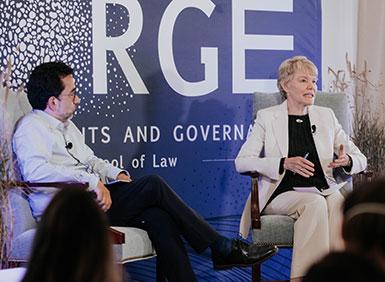During a four-day conference, NYU Law’s Center for Human Rights and Global Justice convened a multinational gathering of lawyers, policy leaders, activists, academics, and artists to exchange ideas and inspiration about the direction of the human rights movement. Titled “The Future of Rights and Governance” (FORGE), the November 2023 event was the first of a planned series of conferences aimed at developing new, transformative concepts and strategies for advancing human rights around the globe.
Among the speakers who gave focused, TED-style talks or participated in discussions were Volker Türk, the United Nations’ high commissioner for human rights; Judge Hilary Charlesworth of the International Court of Justice; Patricia Gualinga, international relations director for the Kichwa First People of Sarayaku; and Kathryn Sikkink, Ryan Family Professor of Human Rights Policy at Harvard University’s John F. Kennedy School of Government.
“What we try to do is curate a conversation among very different actors from around the world,” said César Rodríguez-Garavito, the center's faculty director and a professor of clinical law, as he delivered opening remarks. Recapping the history of the human rights field, Rodríguez-Garavito noted that the past decade has been marked by widespread pessimism in scholarly circles about the movement’s future. He called for an “end to endism” in order to create space for experimentation, debate, and new solutions. “[FORGE] is a very deliberate attempt at instilling hope in human rights and global justice practice,” Rodríguez-Garavito said.
Selected quotations from FORGE discussions:
Judge Hilary Charlesworth of the International Court of Justice: “Many states will sign on to human rights treaties and perform them on one level but work out ways to get around them on another level…. I think one has to take a broader approach to these human rights standards and treaties and see that if we’re just looking for a classic legal use of them, we might be disappointed. But, as [Rodríguez-Garavito’s] work shows, it’s interesting to see the ways these standards can be picked up and used in ways that perhaps weren’t imagined by their founders…. Again, the work of [Julius Silver Professor of Anthropology] Sally Engle Merry here at NYU really emphasized the way that international standards could be vernacularized and used at local levels and that local translations of human rights themselves could influence international standards.”
Volker Türk, United Nations High Commissioner for Human Rights: “Human rights measures are the only way to make development inclusive, participatory, and therefore sustainable; to shape laws that are both just and trusted; to resolve disputes; to ensure our societies are equitable…. They are also the ultimate tool of prevention. Human rights violations are crisis incubators: grievances linked to repression, discrimination, exploitation, and injustice of all kinds lay the groundwork for violence to erupt.”
Watch videos of FORGE conference speakers discussing global justice and human rights.
Posted March 12, 2024
